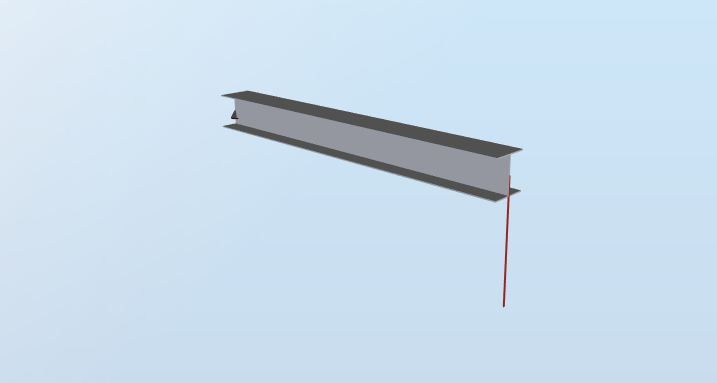Cantilever beam
1 Benchmark
The table above Figure 6.6 in Bell (1987b) analyses the tip displacement of a cantilever beam subjected to a point load at its tip. The beam has an HE300B cross section, with a given shear area
$$A_S = 0.029\text{ m}^2$$
, a second moment of inertia $$I = 0.2517\text{ m}^4$$
, an Elastic modulus $$E = 210\cdot10^9\text{ Pa}$$
and a Poisson ratio of $$\nu = 0.3$$
. This gives a shear modulus $$G = E/(2(1+\nu))=80.8\cdot10^9\text{ Pa}$$
The height of the cross section is $$h = 0.3\text{ m}$$
.For different ratios of length
$$l$$
over height $$h$$
of the beam, the table gives the expected proportion of displacement with and without considering Shear deformation, which in Ashes can be modelled by Timoshenko and Euler-Bernoulli elements, respectively.The data from the table is reproduced below.
$$l/h$$ | 2 | 5 | 10 | 20 |
$$\sigma$$ | 2.88 | 1.30 | 1.08 | 1.02 |
where
$$\sigma$$
is the ratio of the displacement witth Timoshenko elements over the displacement with Euler-Bernoulli elements.For this test, we remove gravity loads and we apply a load
$$P = 100\text{ kN}$$
at the tip of the beam, as shown in the figure below:
The analytical solution of the tip displacement for an Euler-Bernoulli beam can be found for example in Wikipedia as
$$w_E = \frac{Pl^3}{3EI}$$
By using the characteristics of the cross-section and the Euler-Bernoulli analytical solution, we can find the expected tip displacements for different beam lengths and beam theories, as summarised in the table below:
$$l\text{ }(m)$$ | 0.6 | 1.5 | 3 | 6 |
$$w_E\text{ }(m)$$ | $$1.36\cdot10^{-4}$$ | $$0.00213$$ | $$0.0170$$ | $$0.136$$ |
$$w_T\text{ }(m)$$ | $$3.92\cdot10^{-4}$$ | $$0.00277$$ | $$0.0184$$ | $$0.139$$ |
The load cases are run with the Linear and the Nonlinear solvers.
These tests are run both with Rectangular shape and Circular shape cross sections. For the circular shape cases, the beam is defined as having the same properties as the rectangular case in the deformation direction.
This produces a total of 32 load cases.
2 Results
The test is considered passed if the results from Ashes lie within 0.5% of the Benchmark values
The report for this test can be found on the following link:
The test is also run assuming a static simulation. The results are expected to be the same and can be found in this report: